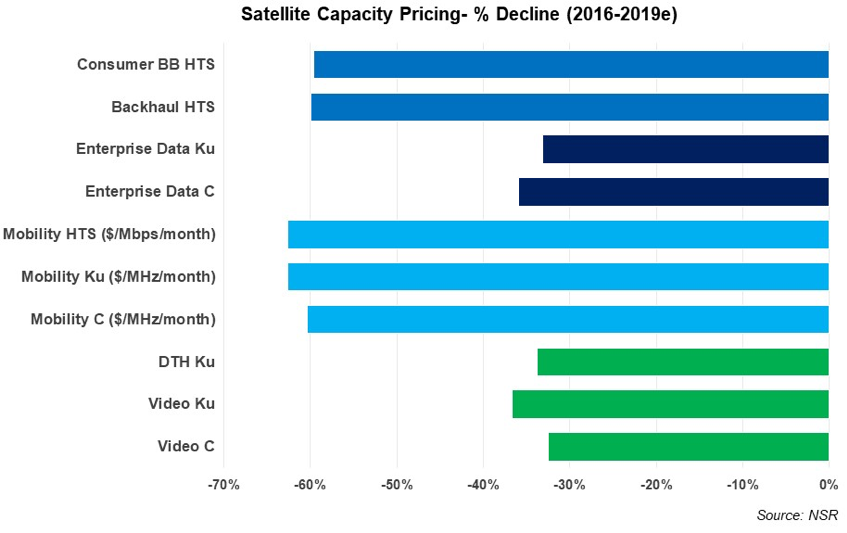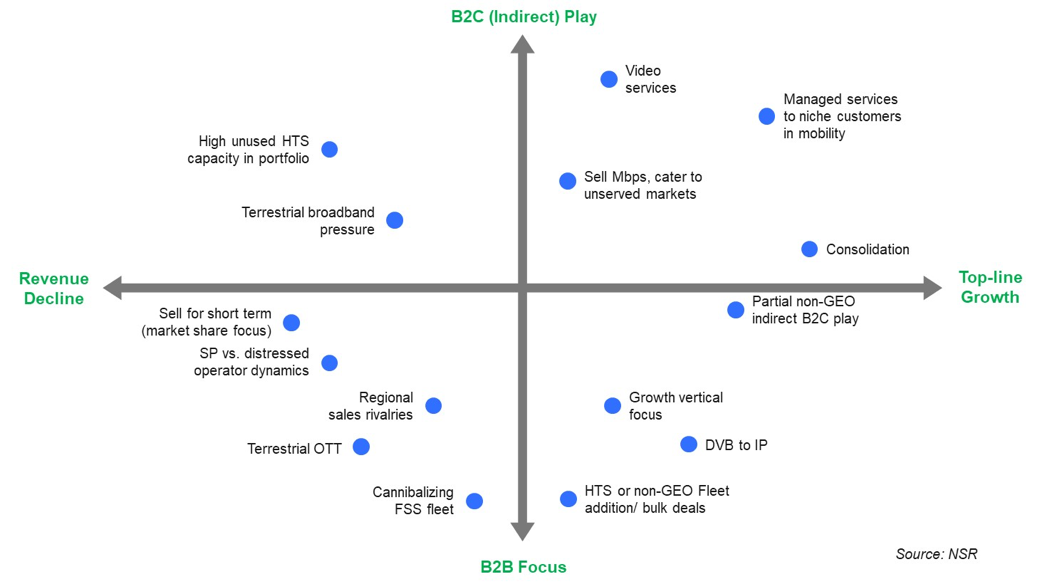The Satellite Capacity Price Conundrum
Mar 26th, 2018 by Gagan Agrawal, NSR
The satellite industry has witnessed a meltdown over the past few years
with capacity prices falling over 30-60% across most verticals. This
decline doesn’t just stem from increased supply and competition, but
also from critical intertwined factors: increased bargaining power of
service providers (SPs) as operators dilute their market positions for
aggressive selling and a correction for high-throughput capacity to
account for CapEx/Gbps cost proportionate to end-lease price. These
drivers essentially mark a sharp transition in the satellite industry,
one that shifts from premium lease models (barring Government segment)
towards a telecom or service industry ARPU-influenced requirement. This
fundamental change due to price declines underpins the question on
sustainability – which we answer by looking at both historical price
drivers and the modus operandi available to satellite operators.

As described in the figure above, NSR’s
report sheds light on the Global Mean Price Index and the performance of
individual verticals over the past 3 years. As with any industry,
buyer-seller dynamics play a strong role in influencing price changes
along with supply-demand, though the current industry faces key
challenges on several fronts. Key changes to price drivers over
the past 2 years include:
-
Decreased focus on duration of lease contract period, and much
higher focus on the bulk amount for lease
-
Plateau in video demand, increase of discounts in backhaul
influenced by low fill rates and increased market share competition
in mobility
-
Price declining not only due to high regional competition but
also from impact of OTT in developed countries, higher efficiencies
for selling Mbps and extensive fiber deployment programs in unserved
areas
These changes indicate the industry must counter the over reliance on
FSS capacity attributes of fill rates, large contract periods and
associated backlogs, regional rivalry on ‘similar’ capacity, and selling
MHz on legacy satellites that are not CapEx/Gbps competitive anymore.
There have been strategies proposed and deployed to counter this, which
are apportioned to a Growth vs Business model exhibit (as below) to
gauge sustainability from a birds-eye point of view.

The need for sustainability stems from both aggressive future price
decline predictions and the induced forced shift in business models. The
inflexion point appears still far away with the industry awaiting more
GEO bulk leases and competition intensifying with pre-anticipation of
LEOs. Dissecting the exhibit above, key points start to emerge:
-
Industry conundrum on operator-service provider dynamics – does a
clear winner here create additional value for the satellite industry
amongst the wider telecom business? Selling Mbps or managed service
or selling severely low-cost CapEx/Gbps seems to be the winning
criteria – business models that both plug the gap in connectivity
demand through satellite architecture and can elastically scale.
-
If the above is true, how sustainable are
FSS operators, as there seem to be more revenue decline factors for
a pure B2B play compared to top-line growth. Cannibalizing legacy
fleets is no more a distant dream as it continues to happen with
C-band in the data vertical; and with tight sales positioning, short
term strategy guidance for regional operators and high bargaining
power with SPs, prices are tumbling faster than expected.
-
If the B2B strategy is not fool-proof, then
do operators have the bandwidth, experience or willingness to go
downstream and fundamentally change their organizational structure
to a service-centric business? With a shift towards indirect B2C
play and LEOs, high EBITDA margins will increasingly become passé
for the industry, as both operators and service providers grapple
with high costs of network management on under-utilized capacity.
Bottom Line
Some options appear more satisfactory than others, and many apply to
regional and global operators differently based on a variety of
strategies. Though, where it seems that an indirect B2C play may
be a winner in the longer term, the question is whether operators are
doing enough and fast enough to move to the top right quarter of the
graph and embrace this fundamental shift? The long-term sustainability
hinges on integration – IP for video, ground equipment for broadband and
mobility, retail play via own satellites to save OpEx, or consolidation
(back-end video services or front-end verticals addition) to create
scale. With prices falling, the industry will be harsh on laggards, and
will reward those who innovate both on fleets and a fluid organizational
structure to adapt to the ‘new customer’ and survive in the next phase
of competition.